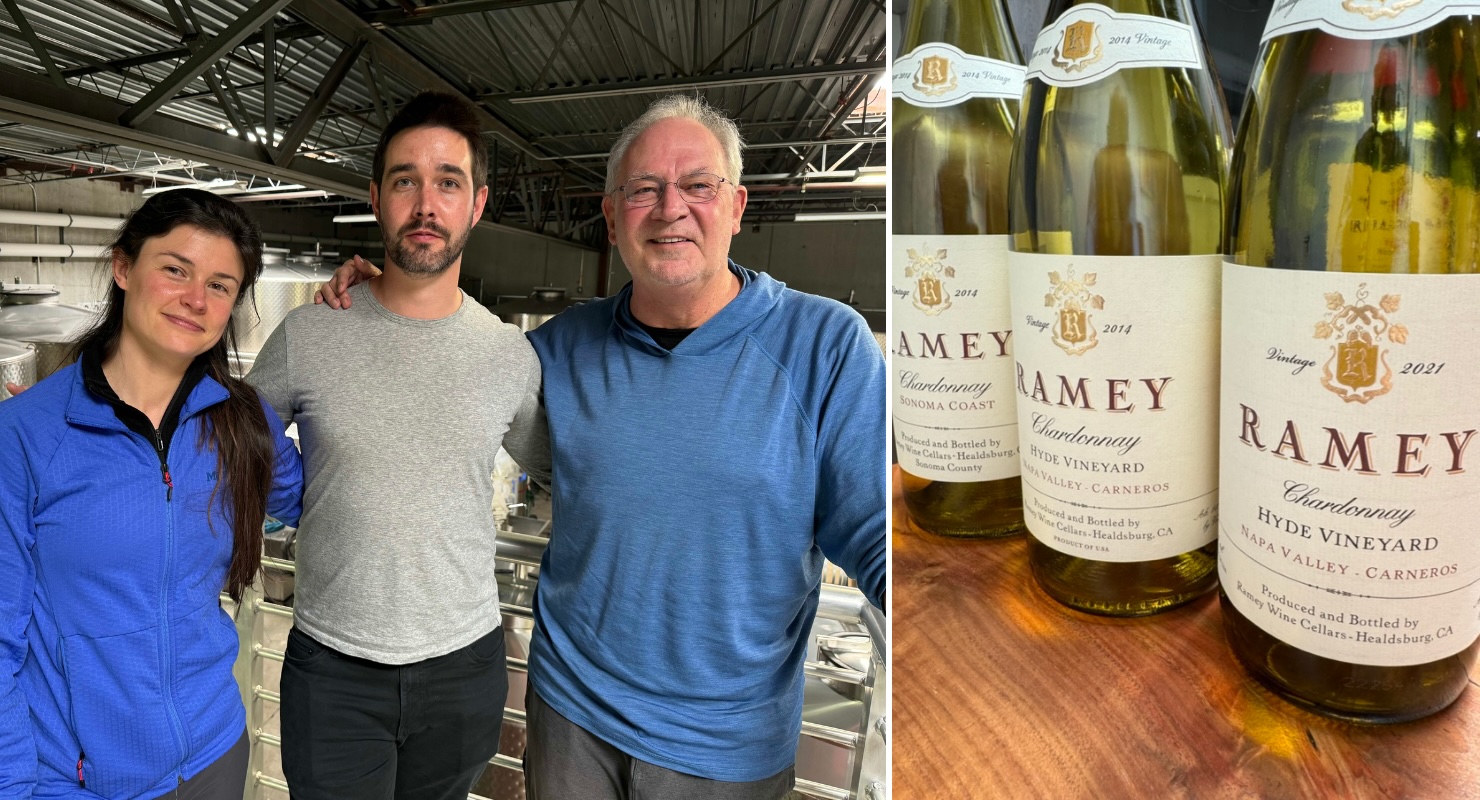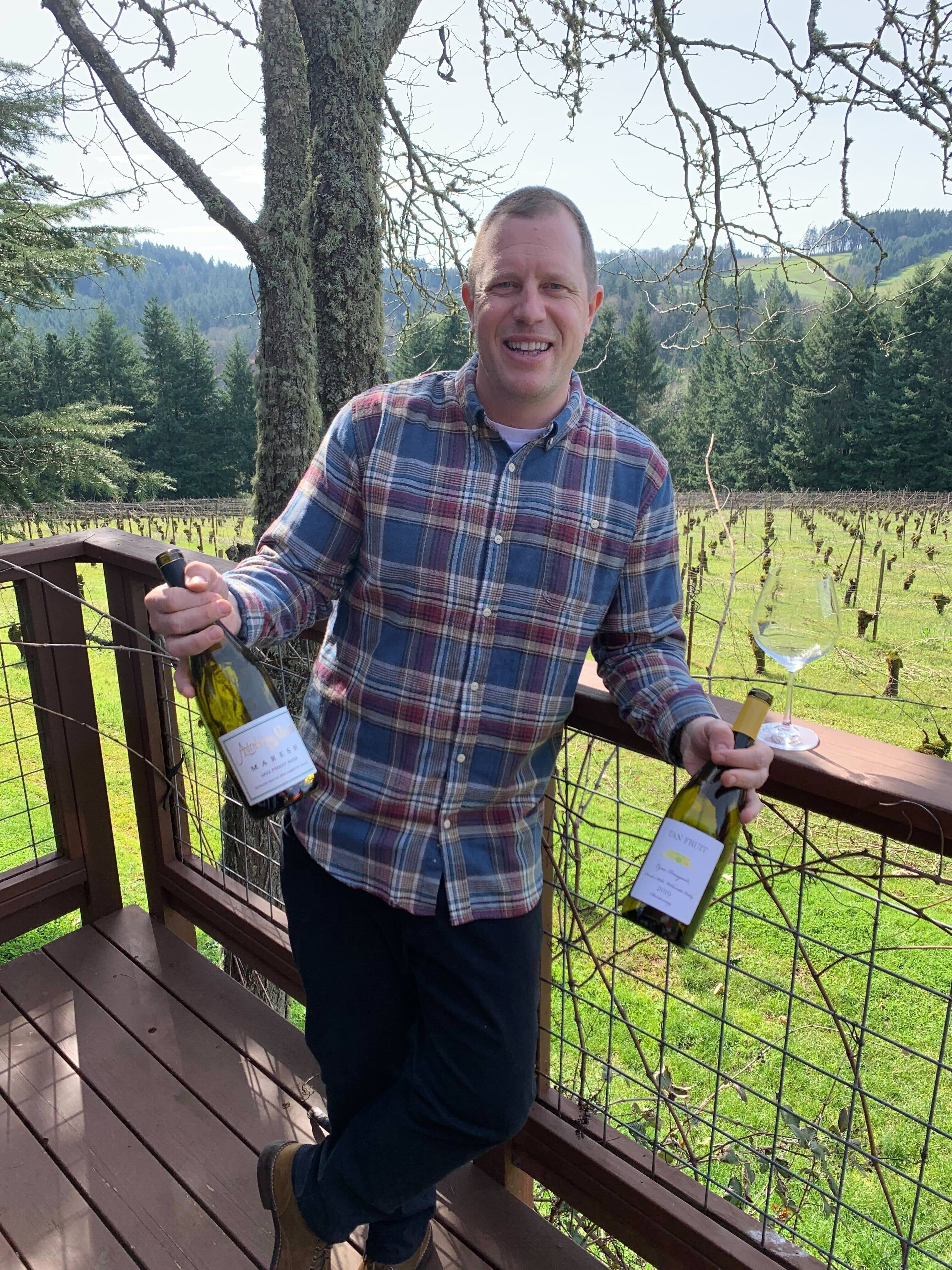
While 2021 cabernet sauvignons dominated the 150-plus wines from California we tasted over the past week, it was chardonnay that really popped. Executive Editor Jim Gordon tasted through the Ramey Wine Cellars lineup and was excited but not surprised to find the chardonnays from David Ramey and his team brilliant in style and emblematic of the low-yield, stellar-quality vintage in general throughout the Sonoma and Napa regions.
Jim said that tasting the great single-vineyard chardonnays with the Ramey family “was like a virtual tour of grand cru sites.” The single vineyards are mostly in Sonoma County, with one in Napa Valley. He tasted with David and Carla Ramey, who founded the winery in 1996, and their children Claire and Alan, who are now co-presidents, along with chief winemaker Cameron Frey and assistant winemaker Lydia Cummins.
It was Jim’s second formal tasting of the Ramey Chardonnay Carneros Hyde Vineyard 2021, which is from an old-vine property planted with even older clones that produced a lavish, concentrated wine. Jim found the intensity of lemon curd, lime zest, vanilla bean and custard flavors to be virtually unmatched, with the tangy acidity perfectly balancing the full body and creamy feel of what he called “a memorable wine.”
CLAIRE RAMEY ON RAMEY’S 2023 CHARDONNAY
Equally high-scoring and even more of a treat was the Chardonnay Hyde Vineyard 2014. Ramey has worked with the same block of Hyde’s Old Wente Clone Chardonnay since 2002, and with the vineyard since 1996. “This 10-year-old library selection is full-bodied and brings out beautiful toasted-almond, tangerine and brioche nuances to top the creamy texture and layers of poached pears on the palate,” according to Jim.
Matching the Hyde Chardonnay in complexity but showing more elegance and minerality was Ramey’s 2021 chardonnay from the Rochioli vineyard in Russian River Valley.

Rochioli normally yields a lighter-feeling, more nervy wine, and this was no exception. It has notes of stone, kiwi and crisp apple, while its light accents of butter and vanilla bean highlight the vibrant green apple and lime flavors. It’s also a cellar-worthy investment.
Very close in ratings were three other Ramey vineyard-designated chardonnays, from the gorgeous, mineral Ritchie Vineyard and the key lime pie-infused Westside Farms Estate to the baked-apples-and-cream texture of the Woolsey Road Vineyard.

This report also highlights excellent cabernet sauvignons and red Bordeaux-style blends from California, including many 2021s, but also a few robust 2020s that escaped the wildfire smoke that year. The “regular” Napa Valley 2020 cab from Sequoia Grove tastes smoke-free, with its brilliant red and black fruits filling out a firm structure of tannins and lively acidity. John Anthony Vineyards also contributed outstanding 2020 cabernets, including the Reserve, Coombsville and Twisted Oak Vineyard releases.
The JamesSuckling.com team always likes to spotlight exciting, fresh wines from less-famous regions, of which there are many in California. This week we feature six outstanding wines from the Markus Wine Co. in Lodi. Markus Niggli, the owner, makes several red blends from heritage grape varieties including carignan, zinfandel and petite sirah grown on old, head-pruned vines, as well as Bordeaux-style blends and a creamy, enticing white called Nativo.


OREGON’S OLD-VINE PINOTS
Tasting Manager Kevin Davy and Associate Editor Andrii Stetsiuk were in the Dundee Hills district of Oregon’s Willamette Valley over the past week, tasting the newest pinot noir and chardonnay releases of Arterberry Maresh and Tan Fruit, both made by winemaker Jim Maresh.
Maresh’s grandfather planted pinot noir in the Dundee Hills in the 1970s and ‘80s, and the old vines are still delivering beautifully today in the pristine and ethereal Arterberry Maresh Pinot Noir Dundee Hills Weber 2022. Maresh said he was grateful to be able to work with 50-year-old vines, although he admitted that “vine age is an unfair advantage” in making pinot noir because of the broad but tense and focused character they give to wine.
Maresh could barely hide his enthusiasm for the one Maresh Dundee Hills chardonnay he poured. It’s from a specific new site that reminded him of Montrachet, the rocky Anela Vineyard. The wine boasts plenty of mineral backbone and a stony character but retains the agility and voluptuous character of the rest of the range.
The Tan Fruit wines, including a large number of site-specific chardonnay cuvees, showcased how Maresh’s winemaking approach counterbalances terroir. The chardonnays we rated from 2019, 2021 and 2022 are all exceptional, coming from unique sites like The Eyrie Vineyard and Oak Grove Vineyard. The Eyrie, from vines planted in 1966, shows tension, bright acidity and focus. Maresh’s most recent addition, the White Walnut Vineyard, has a verticality and verve that helped give it a rating equal to The Eyrie.

PRECISION CHAMPAGNE
Billecart-Salmon has just released two new vintage Champagnes this month. The first, the 2012 Louis Salmon Blanc de Blancs Brut, is made from 100 percent grand cru chardonnay from the Cote des Blancs and showcases precision and finesse, with very fine bubbles, mouth-watering acidity and fantastic structure.
“2012 has a bit more meat around the bone than 2008 has,” CEO Mathieu Roland-Billecart told Associate Editor Claire Nesbitt when they tasted it pre-release in our Hong Kong office. “It’s a good bridge point between 2008 and 2002.
The 2012 Cuvée Elisabeth Salmon Brut Rosé, meanwhile, is a serious rosé Champagne crafted from 55 percent chardonnay and 45 percent pinot noir. It’s focused and complex yet light on its feet, with spicy, yeasty gingerbread undertones to the red fruit.
“When you age rosé longer on lees, it grows in vinosity and becomes more intellectual,” Roland-Billecart said. The base wines are all cold-fermented with minimal use of oak to retain freshness and fruit characteristics, thereby avoiding a “purely intellectual” rosé wine. Both wines are drinking beautifully now after more than 10 years of aging, but have the structure to comfortably lie down for many more years.

PUTTING BEHEMOTHS BEHIND
Many producers in Italy’s Veneto region have hung their hats on Amarone della Valpolicella at the higher end of the pricing spectrum. Amarone is a full-bodied wine made from appassimento, or dried grapes. It was first spoken of in the 1960s as a bastard child of the sweeter Recioto, or a wine that miraculously made it to a point of palpable dryness despite the extract and soaring alcohol levels inherent to fermentations with dehydrated grapes packed with sugar. Growing demand in the United States and later, certain Asian markets, drove demand throughout the 1990s and early 2000s to levels never imagined as the critical zeitgeist embraced rich, often gloopy wine styles at large.
Times have changed.
While Amarone is a sort of halfway house between the frisky, lighter-weighted Valpolicella and luscious Recioto, with each style sharing the same suite of grape varieties, the challenge is finding iterations of Amarone with more drinkable appeal. This is particularly pertinent in an era when lighter and fresher reds, often served on the cooler side, are considerably more popular among mature drinkers than wines of obvious weight and power. With this in mind, it would appear a great opportunity for many a Valpolicella to seize its rightful place alongside the sommelier mantle of cru Beaujolais, Ribeira Sacra, Chinon, McLaren Vale grenache and other crunchy reds. But Amarone?
The best Amarones are considerably less extracted, judiciously oaked, drier and far more refined than they were, even in the recent past. And Amarone’s versatility can transcend its obvious haven: a creased armchair beside a roaring fire, while tucking into a plate of game. Sweet and salty oilier dishes from Shanghai, anyone? Korean barbecue, perhaps?
Best, more producers are striving to craft wines of detail and place, rather than behemoths born of little but the drying room. Cooler vintages – 2012, 2013, 2018 and 2021 – stand out like a beacon of light amid the cauldron of 2017, 2019 and 2020.
The favorites of Senior Editor Ned Goodwin MW included Le Ragose, a traditional producer high up in the Classico zone, responsible for a fine 2013. Evocative of alpine amaro and the carnal whiff of a damp forest floor, the wine is sturdy and savory, if not toothsome and attractively rustic. Brigaldara’s wines, too, are stunning across cuvees, even in climate-challenged vintages such as 2019. They are redder of fruit, lifted and often exotic, with hints of tamarind and clove. They are also very dry in the context of the style, achieved by inoculating with robust yeast that can deal with the heady sugar levels.
“We can’t leave anything to chance,” said Antonio Cesari, the scion of the estate. “To rely on ambient yeast is too risky.” Cesari suggested, too, that initial handling in more oxidative smaller wood confers savoriness to the fruit. He also champions the approach of transferring to larger wood for the remainder of the elevage. Ned concurred, although he added that the new wood is, perhaps, a little too obvious: “If they could eliminate its sweetness, the wines would be even better.”

Ned also enjoyed the wiry tension of the Zyme Amarone della Valpolicella Classico 2018 as well as the extremely refined Amarone della Valpolicella Classico Vigneto Alto 2012 and Riserva 2013 from Bussola – an address that was too reliant on barriques in the not so distant past.
“It is always rewarding to have one’s preconceptions shattered,” Ned noted.
– Jim Gordon, Kevin Davy, Claire Nesbitt and Ned Goodwin MW contributed reporting.
The list of wines below is comprised of bottles tasted and rated during the past week by James Suckling and the other tasters at JamesSuckling.com. They include many latest releases not yet available on the market, but which will be available soon. Some will be included in upcoming tasting reports.
Note: You can sort the wines below by country, vintage, score and alphabetically by winery name. You can also search for specific wines in the search bar.



